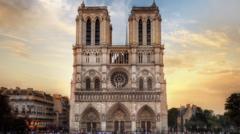The world will catch its first glimpse of a magnificently restored Notre-Dame Cathedral this Friday, as French President Emmanuel Macron takes the stage for a televised tour ahead of the cathedral's much-anticipated reopening. Nearly five years after a catastrophic fire ravaged the iconic Gothic structure, renovations completed under a significant budget of €700 million (£582 million) promise a breathtaking return for one of Paris's most cherished landmarks.
Accompanied by First Lady Brigitte Macron and Archbishop Laurent Ulrich of Paris, President Macron will commence a series of celebratory events leading up to the official reopening on December 7, followed by the first Catholic Mass the next day. During the tour, the President is scheduled to express his gratitude to around 1,300 skilled artisans who played a key role in the project.
Details of the renovation have remained comparatively under-wraps, with few glimpses into the revamped interior. However, those fortunate enough to visit recently rave about the illumination and clarity that now permeates the cathedral, signalling a striking contrast to its formerly dark ambiance. An insider directly involved in the restoration described the experience as nothing short of "splendour," highlighting the immaculate whiteness of the newly finished stone.
On April 15, 2019, viewers around the globe horrified watched as flames consumed the medieval cathedral. The fire, which some speculate was sparked by a discarded cigarette or an electrical malfunction, destroyed the 19th-century spire and the wooden roof supports—known as the "forest"—but spared many of the site's cherished relics. Thanks to the brave efforts of around 600 firefighters, who battled the blaze for 15 hours, the cathedral's core structure was ultimately saved.
Despite initial fears, invaluable treasures including stained-glass windows, art, and the historic Crown of Thorns survived the inferno, though the cathedral's grand organ sustained damage. Other miraculous recoveries include a statue from the 14th century and sculptures that narrowly escaped destruction as masonry fell.
In the aftermath, President Macron boldly pledged to restore Notre-Dame within five years, leading to the establishment of a public organization dedicated to the restoration process and a fundraising campaign that accumulated approximately €846 million in donations. The project has served as a lifeline for traditional French craftsmanship, creating thousands of apprenticeships in the artisanal trades.
Key challenges arose during renovations, notably debates over faithfully reconstructing the original design versus incorporating modern elements. Ultimately, architects opted for a historically accurate restoration with some modern refinements, such as reinforced sprinklers.
However, Macron's vision for contemporary stained-glass windows continues to incite a heated discussion among the artistic community. Critics argue that the existing designs hold significant cultural heritage, whereas proponents of a modern approach highlight the importance of innovation.
As Macron navigates fluctuating political fortunes, the reopening of Notre-Dame symbolizes unity and resilience within French society. Some critics suggest the timing of the televised event feels overly self-promotional, but officials stress the government's crucial role in expediting the restoration process.
It is through collective determination—a defining French quality—that Notre-Dame has risen anew. With a deep sense of pride, the world will witness the restoration of this grand architectural marvel, which stands not only as a cherished national landmark but also as a testament to the indomitable spirit of hope and perseverance.




















